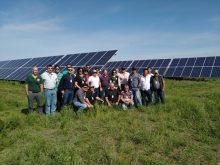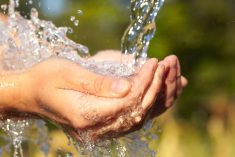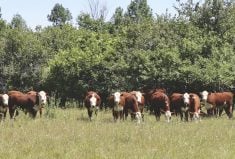From the highway, the sign seems out of place. “Now open, Southern Irrigation,” it declares.
Down Lethbridge way, it might not be unusual to see a yard full of irrigation pipes and reels of tubing. But Red Deer isn’t exactly the epicentre of irrigation in the province.
But that may slowly be starting to change, said Southern Irrigation’s Andrew Neels.
“The past five years have been really dry, and farmers are starting to get worried,” said the company’s Red Deer location leader.
“Water isn’t on people’s minds right now because of how much rain we’ve got, but the trend is toward hotter weather and less precipitation. Combine that with our existing customer base here and the different sectors that we’re in, it was just a good business move to come up here.”

Southern Alberta has been the hotbed for irrigation in the province since the late 1800s, when the first irrigation ditches were created to divert water from the Oldman and Bow rivers. Today, most of the province’s irrigation is still concentrated in 13 Irrigation Districts across 1.6 million acres in southern Alberta.
But there are another 300,000 acres of private irrigation reaching as far north as the Peace Country. And companies such as Southern Irrigation expect to see those numbers climb even higher as farmers in central and northern Alberta explore the benefits of irrigation.
“The old motto was, ‘We’re not getting enough yield — let’s just purchase more land.’ Well, now with land prices increasing, we’re seeing a lot more farmers trying to get the most out of the land they have,” said Neels.
Read Also

Farming Smarter receives financial boost from Alberta government for potato research
Farming Smarter near Lethbridge got a boost to its research equipment, thanks to the Alberta government’s increase in funding for research associations.
“Everything grows better with more water. I can double, triple, even quadruple my production just by putting a bit of extra water on it over the year. If you’ve got the river right there, it’s almost a no-brainer.”
Irrigating near Edmonton
That’s the story behind the pivots at Ruskei Farms, a mixed operation north of Fort Saskatchewan that has been irrigating its seed potatoes from the Sturgeon River for more than 30 years.
“Potatoes demand a high amount of water, and that’s been the drive for us — to make sure our potato acres are irrigated,” said Keith Goutbeck, who operates the farm with his cousin Russell Van Boom.
“It’s a great way to be sustainable as a farm and to secure your future, by ensuring you’re producing the best quality you can.”
Goutbeck’s grandfather first started exploring irrigation in the 1960s when he put in his first 20 acres of potatoes, and the next generation — Goutbeck’s father and uncle — ran with it, expanding their irrigated acres as their land base grew.
“We’ve been using that river for many years to sustain this farm,” said Goutbeck. “My dad and uncle have invested a lot into irrigation here. It’s had great returns for us, especially in a drought year.”
Today, Ruskei Farms is home to an intricate web of irrigation pumps and pivots and pipes. Down by the river are two permanent pumps that have underground lines running to the farm’s pond and then to the pivots in their home fields and rented land across the road.
Some pivots are permanent, others can be moved to where they’re needed most. And that flexibility has given Goutbeck and Van Boom a boost not only for their potatoes, but for grain crops as well.
“If we have a dry year and the pivot isn’t able to be moved, we’ll just water the canola or the wheat and benefit from that irrigation too,” said Goutbeck, adding the majority of their grain is strictly dryland.
“It really does make a difference on our grain crops. Last year, we had about a month and a half of no rain, and we watered a couple of times in that field. It definitely proved to have a higher yield.”
That difference has been even more pronounced in a drought year.
“We’ve seen anywhere from 15 to 20 bushels more in our wheat.”
For northern growers — particularly specialty crop growers — that’s when irrigation systems really start to pay off.
“We had a pretty serious drought year in 2002, and I remember having to get more pumps and tractors to move water. It was a pretty desperate time,” said Goutbeck.
“Since then, it’s stuck with all of us to invest more in irrigation. It saves a lot of time when you’ve got it all there, ready to go. It pays to have it in place.”
Slow northward expansion
Even so, any northward expansion in Alberta’s irrigation system is likely to be slow, said Jennifer Nitschelm, director of the basin water management section and irrigation secretariat for Alberta Agriculture and Forestry.
Over the past 20 years, Alberta’s irrigated area in central and northern Alberta has remained “relatively constant,” while irrigation in southern Alberta has been increasing steadily as a result of the growing conditions in the south.
“Being a semi-arid climate, southern Alberta does tend to be drier and more vulnerable to droughts, but northern and central Alberta have also experienced periods of drought,” said Nitschelm.
“If we were to see warmer conditions, longer growing seasons, and more variability in when we receive precipitation, I expect that would drive interest in irrigation among more northern producers.”
At the moment though, farmers are mostly just “kicking tires” when it comes to irrigating in central and northern Alberta.
“In places where there’s access to water and good agricultural land, they’re starting to explore what the opportunity to develop irrigation really is,” she said. “It’s an interesting thought. It would be fun to be around in 100 or 200 years to see what actually does develop.”
But there are many factors to consider, she cautioned.
“It is, of course, quite a capital investment, so they’d definitely want to consult with an irrigation specialist first,” she said.
The next step is applying for a water licence through Alberta Environment and Parks — if new applications are being accepted, that is. The South Saskatchewan River Basin has been closed to new water licence allocations since 2006, and a number of other basins (mostly in southern Alberta) are also closed to new licences.
“But I believe there’s more opportunity in the northern basins to be able to apply for a water licence for irrigation,” said Nitschelm. “Certainly if farmers have land within a reasonable proximity to a water source and if the cost of putting in infrastructure to pump and convey that water is reasonable, I think there is an opportunity for producers in central and northern Alberta to consider irrigation.”
Reliable access to water is key, Goutbeck added.
“If you’re going to invest in it, you’ll want to make sure that water’s available every year so that you don’t have a year of not being able to use your irrigation system,” he said.
Usually by mid-July, the Sturgeon River is running dry, so Ruskei Farms relies on its reserves to keep its irrigation going.
“It can be dicey. Some days, we can pump because there’s enough water from the river, and some days, we can’t,” he said.
“We’re fortunate that we’re so close to the river and have access to it all the time, but we still have backup plans for those dry years, including reservoirs and a pond.”
Northern farmers will also need to make sure their land is suitable for irrigation, added Nitschelm.
“Land does have to be classified to make sure the soil and topography characteristics would support irrigation.”
Perhaps more importantly, they’ll need to determine if the return would be worth the investment.
“They would really want to understand what the benefits would be to the crops they produce in their area and whether there would be opportunities to potentially introduce new crops because of irrigation,” said Nitschelm.
Drip irrigation systems
Seeing that return on investment has been the biggest challenge for Ruskei Farms.
Central and northern Alberta typically don’t see the same dry conditions as the south, so while Goutbeck needed to irrigate last year, this year’s wet weather has left his pivots idle.
“Last year, we used it, so it was worth it. But this year, we haven’t turned a single irrigation system on,” he said.
But where he sees the benefit is in specialty crops like the seed potatoes they grow.
“I’m not too sure it’s feasible to purchase irrigation just for a grain crop,” said Goutbeck.
“As grain yields increase, it’s starting to make more sense, but it’s always going to be more expensive if you’re not diversified. It will pay, but it could take many years. It could take your whole career, depending on the weather. So you might want to have other crops in there that would make the irrigation pay faster.”
The type of equipment is another factor, Neels added. In southern Alberta, sprinklers and pivots are still common, but in central and northern Alberta, drip irrigation systems will likely be more popular among growers, particularly those who are on a well or who are using drainage to redirect water from wetter areas to dugouts for storage.
“There’s very limited access to water up here, so the more efficient people can be with their watering, the better. And there is no more efficient way to irrigate than with drip irrigation,” said Neels.
“A lot of people aren’t keen on the whole drip thing, but they don’t realize they can irrigate eight times the amount of area with drip using the same amount of water as sprinklers.”
The growing demand for drip irrigation systems was one of the drivers behind Southern Irrigation’s expansion north, he added. Its Lethbridge location began to receive more demand from customers north of Calgary, and the company saw an opportunity to supply fast-growing industries in the more northern parts of the province.
“What we are seeing is some irrigation for different specialty crops that have a higher demand for water,” said Neels.
Right now, the interest in northern irrigation has mainly come from Hutterite colonies, tree nurseries, sod farms, market gardens, and cannabis production facilities, but some hay producers and field crop growers have incorporated irrigation on their operations.
Neels expects that trend to continue based on what he’s seen so far in the Red Deer location, which officially opened in May.
“In May, we got tons and tons of calls because there wasn’t any rain, and it looked like it was going to be another one of those really dry years,” said Neels.
That sense of urgency retreated when rains resumed, said Neels. But even so, producers should be thinking ahead now and exploring whether irrigation might have a fit on their operations someday.
“Once the rain is falling, it’s not a big deal — until we get another month of dryness. Come another dry month, having a system in place is going to help,” he said.
“You can’t anticipate the future, but you can prepare for the worst. Droughts happen all the time.”














